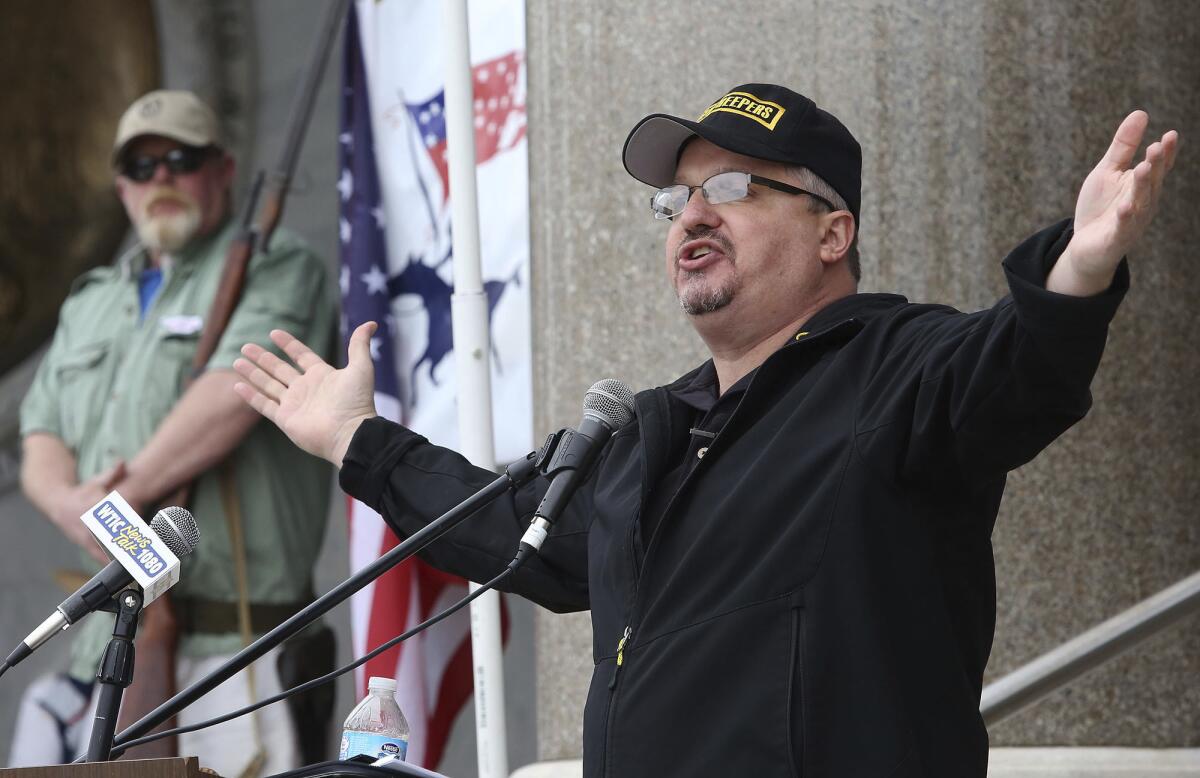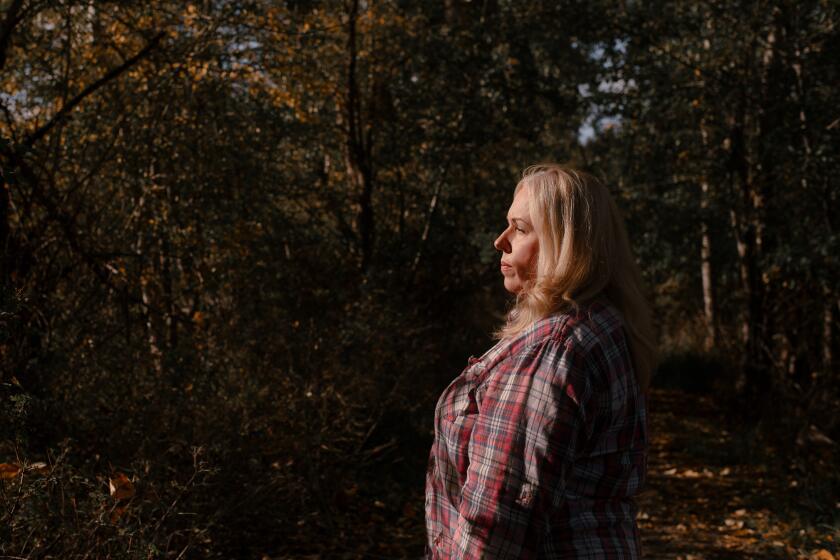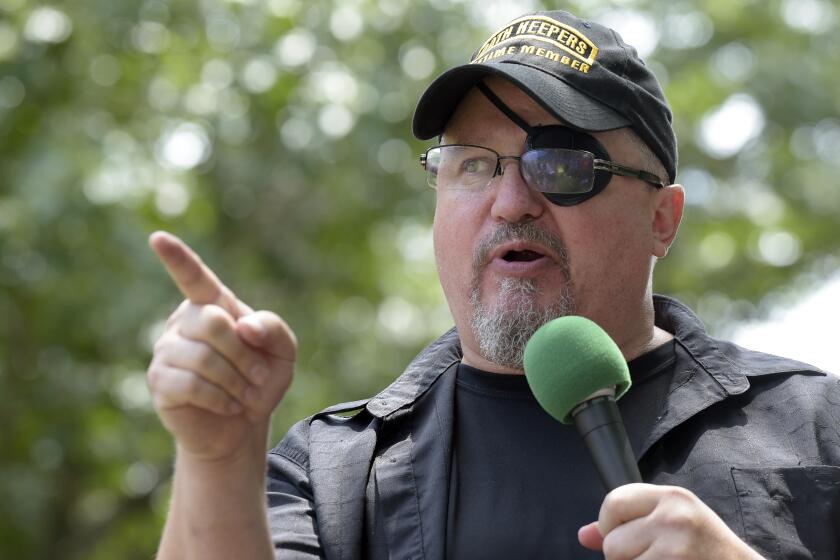Founder of Oath Keepers charged with seditious conspiracy

- Share via
WASHINGTON — Stewart Rhodes, the founder and leader of the far-right Oath Keepers militia group, has been arrested and charged with seditious conspiracy in the Jan. 6, 2021, attack on the U.S. Capitol, authorities said Thursday.
Rhodes is the highest-ranking member of an extremist group to be arrested in the deadly siege, and it is the first time the Justice Department has brought a seditious conspiracy charge in connection with the attack on the Capitol.
Rhodes, 56, of Granbury, Texas, and Edward Vallejo, 63, of Phoenix were arrested on Thursday.
Rhodes is charged along with more than a dozen other members and associates of the Oath Keepers, who authorities say came to Washington intent on stopping the certification of President Biden’s victory.
The arrest of Rhodes and the others is a serious escalation of the accusations against the thousands of rioters who stormed the Capitol.
And the charges answer, in part, a growing chorus of Republicans who have publicly questioned the seriousness of the Jan. 6 insurrection, arguing that since no one had been charged yet with sedition or treason, it could not have been so violent.
Rhodes did not enter the Capitol on Jan. 6 but is accused of helping put into motion the violence that disrupted the certification of the vote. The Oath Keepers case is the largest conspiracy case federal authorities have brought over Jan. 6, when thousands of pro-Donald Trump rioters stormed past police barriers and smashed windows, injuring dozens of officers and sending lawmakers running.
The indictment against Rhodes alleges Oath Keepers formed two teams, or “stacks,” that entered the Capitol. The first stack split up inside the building to separately go after the House and Senate. The second stack confronted officers inside the Capitol Rotunda, the indictment said. Outside Washington, the indictment alleges, the Oath Keepers had stationed two “quick reaction forces” that had guns “in support of their plot to stop the lawful transfer of power.”
The estranged wife of Oath Keepers founder Stewart Rhodes talks about her role in the group accused of playing a part in the Jan. 6 Capitol riot.
Jonathan Moseley, an attorney representing Rhodes, said his client was arrested in Texas.
“He has been subject to a lot of suspicion to why he wasn’t indicted” so far in the Jan. 6 riot, Moseley said. “I don’t know if this is in response to those discussions, but we do think it’s unfortunate. It’s an unusual situation.”
Moseley said that Rhodes was supposed to testify before the House committee investigating the Jan. 6 insurrection in a deposition but that it got called off. He was talking to Rhodes on the phone about the committee when Rhodes was contacted by the FBI.
Rhodes has said in interviews with right-wing hosts that there was no plan to storm the Capitol and that the members who did so went rogue. But he has continued to push the lie that the 2020 election was stolen, while posts on the Oath Keepers website have depicted the group as a victim of political persecution.
Authorities have said the Oath Keepers and their associates prepared in the weeks leading up to Jan. 6 as if they were going to war, discussing weapons and training. Days before the attack, one defendant suggested in a text message getting a boat to ferry weapons across the Potomac River to their “waiting arms,” prosecutors say.
On Jan. 6, several members, wearing camouflaged combat attire, were seen on camera shouldering their way through the crowd and into the Capitol in a military-style stack formation, authorities say.
Oath Keeper defendants have argued in court that the only plan was to provide security at the rally before the riot or protect themselves against possible attacks from far-left “antifa” activists.
Rhodes, a former U.S. Army paratrooper and Yale Law School graduate who founded the Oath Keepers in 2009, has appeared in court documents in the conspiracy case for weeks as “Person One.”
Authorities say Rhodes held a GoToMeeting call days after the election, telling his followers to go to Washington and let Trump know “that the people are behind him.” Rhodes told members they should be prepared to fight members of the the anti-fascist political movement known as antifa and that some Oath Keepers should “stay on the outside” and be “prepared to go in armed” if necessary.
The Justice Department faces challenges in seeking to prosecute Oath Keepers founder Stewart Rhodes because he stayed outside the building.
“We’re going to defend the president, the duly elected president, and we call on him to do what needs to be done to save our country. Because if you don’t guys, you’re going to be in a bloody, bloody civil war, and a bloody — you can call it an insurrection or you can call it a war or fight,” Rhodes said, according to court documents.
Authorities have said that Rhodes was part of an encrypted Signal chat with Oath Keepers from multiple states leading up to Jan. 6 called “DC OP: Jan 6 21” and that it showed the group was “activating a plan to use force” that day.
On the afternoon of the 6th, authorities say Rhodes told the group over Signal: “All I see Trump doing is complaining. I see no intent by him to do anything. So the patriots are taking it into their own hands. They’ve had enough.”
Around 2:30 p.m., Rhodes had a 97-second phone call with Kelly Meggs, the reputed leader of the group’s Florida chapter, who was part of the military-style stack, authorities say. About 10 minutes later, Rhodes sent a photo to the group showing the southeast side of the Capitol with the caption, “South side of US Capitol. Patriots pounding on doors.” Around that same time, those in the stack formation forcibly entered the Capitol, prosecutors say.
The Oath Keepers and members of other extremist groups, such as the Proud Boys, make up just part of the more than 580 people who have been charged in the riot. But several of their leaders, members and associates have become the central targets of the Justice Department’s sprawling investigation as authorities work to determine to what extent the attack was plotted in advance.
The last time U.S. prosecutors brought such a seditious conspiracy case was in 2010 in an alleged Michigan plot by members of the Hutaree militia to incite an uprising against the government. But a judge ordered acquittals on the sedition conspiracy charges at a 2012 trial, saying prosecutors relied too much on hateful diatribes protected by the 1st Amendment and didn’t, as required, prove the accused ever had detailed plans for a rebellion.
Among the last successful convictions for seditious conspiracy stemmed from another, now largely forgotten storming of the Capitol in 1954, when four Puerto Rican nationalists opened fire on the House floor, wounding five representatives.
Overall, the bar for proving sedition isn’t as high as it is for the related charge of treason. Still, sedition charges have been rare and are difficult to win.
More to Read
Get the L.A. Times Politics newsletter
Deeply reported insights into legislation, politics and policy from Sacramento, Washington and beyond. In your inbox three times per week.
You may occasionally receive promotional content from the Los Angeles Times.












